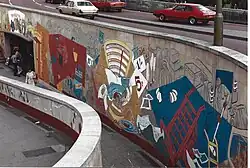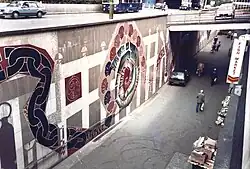West Midlands Public Art Collective
West Midlands Public Art Collective was initially formed in 1984 in response to a commission opportunity (managed through the regional art association, West Midlands Arts) for a site in Birmingham city centre owned by West Midlands County Council.[1] Its members were:[1]
West Midlands Public Art Collective (WMPAC) exemplified the shifting landscape of UK public art policy in the 1980s and 1990s, particularly in terms of cultural democracy, regionalism, and urban regeneration. As a response to a growing interest in public art that reflected local identities, community voices, and post-industrial urban renewal in Birmingham and the wider West Midlands region, it was an early example of the development of essential infrastructure for public art practice. WMPAC's activities included:
• core group commissions;
• sub-contracted commissions to other artists;
• design strategies and master plans for the County Council;
• a Public Art Centre that accommodated artists' studios, an exhibition space, and which hosted a regional 'Art, Architecture and Landscape Group';
• a range of exhibition and event-based initiatives, including 'Artists-in-Public'.
The Collective's core commissions included a relief mural for Bell Street Passage in Birmingham, installed in 1987 and now lost, which was a pivotal example of how artists responded to evolving public art policy by producing inclusive, public‑oriented, and regeneration‑aligned artworks within a broader context of post-industrial urban regeneration and related cultural policy in the UK during that period.[1]
WMPAC’s formation coincided with broader shifts in UK cultural policy. In the 1970s and early 1980s, the Arts Council of England and regional arts boards began promoting community-based and socially inclusive practices. This extended arts practice aligned with cultural democracy to decentralise art from elite institutions and bring it into everyday life. WMPAC's projects often reflected local narratives, working-class culture, and industrial heritage.
The 1980s and 1990s also saw public art increasingly tied to urban regeneration under neoliberal policies. As Thatcher-era cuts to public spending pushed local authorities toward public-private partnerships, art became instrumental in place-making and softening the impacts of redevelopment. WMPAC adapted by working with planners, architects, housing associations, and educational institutions, embedding their art within architectural features and urban landscapes. Their work balanced urban renewal with community pedagogy, often involving schools and local residents.
WMPAC’s funding came from diverse sources—West Midlands Arts, local authorities, the Arts Council, private developers, and the education sector—reflecting evolving models of arts support. While this funding ecology enabled responsiveness and adaptability, it also introduced potential constraints, as projects had to align with institutional or civic expectations.
Artistically, WMPAC was defined by collaborative, artist-led processes. Members maintained aesthetic authorship while facilitating local participation. Their works, typically made from durable materials like steel, glass, and mosaic, were designed to be long-lasting and integrated into the public realm. The collective navigated tensions between artistic autonomy and social function, embodying the dual imperatives of formal innovation and public utility.
Joint winners of the 1987 City of Birmingham Fine Art Award, WMPAC’s legacy lies ultimately in its synthesis of community engagement and artistic authorship. It reflects the complex evolution of UK public art policy and remains influential in shaping participatory, place-based art in the Midlands and beyond.
Significant Documentation:
1986 BBC2 | General Studies Art and Upheaval: Art and Society
12.40pm Monday 13 October 1986 (filmed in 1985)
"What use is art? How far should artists concern themselves with the social issues of their times? And if they do so, how effective is art as a means of moulding opinion?”
1986 Terry Grimley: 'Street Art…’, The Birmingham Post (29.12.1986)
“…its occupants have their eyes on a huge and highly prominent exhibition space — the entire city.”
1987 Stuart Crees: 'The New Spirit of Public Art – Art on the Street’, Arts Report, West Midlands Arts (April 1987)
“…the mission of transforming the city’s streets."
1987 Bombin Documentary About British Graffiti and Hip-Hop Culture
Bombin, produced by Dick Fontaine and Pat Hartley, captures the UK graffiti scene at a pivotal moment, as TATs Crew and Zulu Nation member Brim Fuentes leaves the South Bronx to travel across the Atlantic, reluctantly adopting the role of ambassador for graffiti and hip hop’s emerging crossover appeal. Meeting 3D and Goldie along the way, the film draws parallels between the inner city lives and subcultures of its main protagonists, from the council estates and social housing of Bristol and the Midlands, then back to the Bronx. Shown Arnolfini, Bristol, 24.10.2021.
2020 Sky Arts | Goldie: The Art That Made Me
9.00pm Tuesday 1 December 2020
"Renowned visual artist and musician Goldie goes on a personal and passionate journey into the world of graffiti and street art. "Goldie talks to Brim and Bio about their experiences. We then see Goldie, Brim, 3D (Robert Del Naja) and other artists creating art in Birmingham city centre for a council run project. They also chat to local mural artists David Patten and Steve Field about their methods.”
Works
| Picture | Work | Location | Date | Type | Material | Dimensions | Designation | Coordinates (With links to map and aerial photo sources) |
Owner | Notes |
|---|---|---|---|---|---|---|---|---|---|---|
| City of a Thousand Trades | Bell Street Passage, Birmingham | 1987 | Relief |
|
commissioned by the then West Midlands County Council; lost[1]
|


References
- ^ a b c d Tilson, Barbara (November 1991). "Art for the People". RIBA Journal. 98 (11): 41.